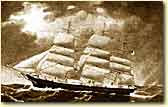 Shown above:
Shown above:John Sutter, the man who owned the property in which the gold was found. When the gold was found he wanted it to remain a secret so that his employees would not leave, and search for gold. John was originally from Switzerland and arrived in the United States in 1839. John built a fort that he called Sutter's fort, later the fort became a rest station for travelers and immigrants.
Shown below:
James Marshall, the man who found gold in the Sacramento River on January 4, 1848 while building Sutter's mill. John Sutter hired him for carpentry in the Sacramento valley where he later owned acreage and a farm. Though he discovered the gold, he never struck it rich.
 Shown below:
Shown below:Sutters Mill, the place where James Marshall discovered gold. Gold was discovered on Jan. 24th, 1848 when James Marshall was checking to make sure that the mill's trailrace had flushed out all the debris and silt from the mill.
 Shown Below:
Shown Below:Sutter's Fort (location of Gold Rush), a fort in which John Sutter created for migrating immigrants who came to the Sacramento Valley.



 Shown Left:
Shown Left:The Oregon-California on land trail. Minors who took this route traveled in wagons. The advantage of wagon travel was that the minors could take many supplies unlike the people on the ships.
Shown center: Around cape horn trail. It was the longest journey and was traveled on ships. Many men were sick on these ships and caught horrible diseases.
Shown left:
Panama shortcut trail. Minors traveled on ships, but these ships didn't reach S. America. Many men caught disease on these shapes.
Shown below and bottom left:
These are examples of the ships that journeyed to California from around the world. Many men were sick on these ships and they couldn't bring as many supplies for mining.
Shown bottom right:
- A white man's slave in which he brought to California to help search for gold. Many men brought along their slaves to help them search for gold in the river.



Shown right:
Minors camp in California. Most men slept in tents or in mining houses where there were many men in one room. They typically ate bacon, beans, rice, ham, dried fruit and other simple foods.
Shown below:
A typical wagon camp where minors slept or where families who had come along to California stayed.



Shown above left:
- Minors mining pan in which they used to find gold. The sand would float away and the gold would sink to the bottom of the pan. The pans were typically made of wood and would cost around $8.00 for 4.
- Minor's would shovel and pick to get the gold that wasn't just floating or sitting at the bottom of the river.
- typical minors clothes. Minors weren't able to bring many clothes on the long trip to California, so their clothes got wet and dirty while mining for gold.
Shown above right:
Minor's 10 commandments.

Above:
A typical gold nugget which was found in the Sacramento River in California.
On right:
San Francisco during the gold rush. The town and shops were very busy and the prices went up during the gold rush.
On right:
Mexican flyer advertising the Gold Rush.
Deborah's deign team
Emma Frank and Rory Reichelt

JOHN SUTTER
John Augustus Sutter was born on February 15, 1803 in Kandern, Baden, Switzerland. He started his Career as an apprentice of a printer and bookseller, but decided it was "not for him." In October 24, 1826 he married a magnificent lady named Annette O'beld, later they had four children together. After 10 years of business failures he left his family and came to America. He joined a trapping party that was going to the West coast. But a detour led him to California where he began his dream of building an "empire." John created a farm that he called "Hock Farm" which supplied settlement at Sutter's fort. Sutter's Fort was completed in 1844. John used the fort mostly as a trading post. He hired local Native Americans, hunters, blacksmiths, and a carpenter. Here James Marshall discovered gold at his saw mill. Once the gold was found John wanted to keep it a secret so that his workers would not leave. But word got out and that started the California gold rush. In 1850 he was reunited with his wife and kids they moved from the chaos to Hock farm. In 1865 a small band of men set the house on fire totally demolishing it. This forced them to move to Pennsylvania where he lived out the rest of his life.

James Wilson Marshall
James Wilson Marshall was born October 8, 1810 to his parents Phillip and Sarah Marshall in
James Marshall took up his father’s carpentry and trade skill which brought him to working for John Sutter in July, 1845 as a carpenter and sawmill operator. He built Shutters Mill on the
In 1857,






No comments:
Post a Comment